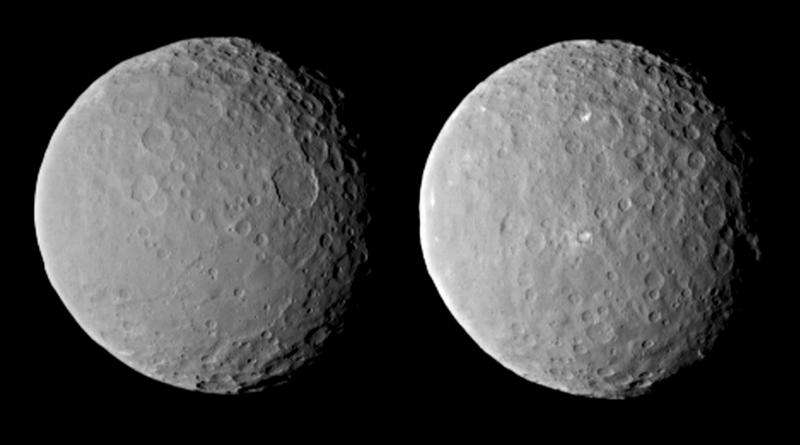Biggest in the Solar System - Facts for Kids

Images of dwarf planet Ceres from NASA’s Dawn spacecraft. Ceres is the biggest asteroid.
The biggest impact crater on Earth is the Vredefort crater in South Africa, and the highest mountain is Everest. But what about the rest of the Solar System? Which features are the biggest ones in the whole Solar System?
The biggest impact crater on Earth is the Vredefort crater in South Africa, and the highest mountain is Everest. But what about the rest of the Solar System? Which features are the biggest ones in the whole Solar System?
- The biggest planet is Jupiter.
Most people know that. But did you know that Jupiter has enough mass to make two copies of all the other planets and moons? (And still have a lot of material left over.) - The biggest moon is Jupiter's moon Ganymede.
Ganymede is 5262 km (3270 miles) across. It's only 112 km (70 miles) bigger than Saturn's moon Titan. Both moons are bigger than the planet Mercury. - The biggest dwarf planet is Pluto.
Eris is almost as big as Pluto. One day we might discover a dwarf planet bigger than Pluto. - The biggest asteroid is Ceres.
Ceres is the smallest known dwarf planet, but it's the largest asteroid. It's about 900 km (600 mi) across. Vesta, the second largest asteroid, is only about 500 km (300 mi) across. - The tallest mountain is the central peak of the Rheasilvia Crater on the asteroid Vesta.
NASA's Dawn mission found that the mountain is at least 22 km (14 miles) high from top to bottom. On Earth, the tallest mountain is Mauna Kea in Hawaii. It's just over 10 km (almost 6½ mi) from base (bottom) to summit (top). Mauna Kea doesn't reach as high as Everest does, but it's bigger from its base on the sea floor to its summit. - The tallest volcano is Olympus Mons on Mars.
Mauna Kea is Earth's tallest volcano, but Olympus Mons is more than double the height of Mauna Kea. It's nearly the same height as the mountain on Vesta. - The biggest lake is Kraken Mare on Saturn's moon Titan. It's not a lake of water, but a lake of liquid ethane and methane. On Earth, ethane and methane are flammable gases, but in the extreme cold of Titan, they are liquid. Kraken Mare is about 400,000 square km (154,000 square miles). The biggest lake on Earth is the Caspian Sea which is close to 371,000 square km (143,000 square miles). Despite its name, the Caspian Sea is usually considered to be a lake.
- The biggest river in the Solar System is on Earth - it's either the Amazon or the Nile.
The Nile used to be listed as the longest, but new information about the Amazon suggests it might be slightly longer than the Nile. They're both close to 7000 km (4300 mi) long. There isn't much competition on other worlds. The only other world with flowing rivers on the surface is Saturn's moon Titan. Vid Flumina, a river of methane and ethane, is the longest river on Titan, over 400 km (250 mi) long. - The biggest impact crater in the Solar System is the North Polar Basin on Mars.
An impact crater is made when a large space object hits a planet or moon. The biggest impact crater on Earth is the Vredefort Crater in South Africa. It was originally around 300 km (190 mi) across, but it's smaller after two billion years of weathering and erosion. It's tiny compared to the North Polar Basin on Mars which is 10,600 x 8,500 km (6,550 x 5,250 mi) – an area bigger than the United States. - The biggest rift valley in the Solar System is in the Atlantic Ocean on Earth.
A rift valley is created when a planet's crust cracks because of activity inside the planet. The rift in the Atlantic Ocean is about 10,000 km (6000 mi) long, 6000 km (4000 mi) wide and nearly 8 km (5 mi) deep. The biggest rift valley elsewhere is the Valles Marineris on Mars.
You Should Also Read:
Vesta Facts for Kids
Titan Facts for Kids
Dwarf Planets - a Tour

Related Articles
Editor's Picks Articles
Top Ten Articles
Previous Features
Site Map
Content copyright © 2023 by Mona Evans. All rights reserved.
This content was written by Mona Evans. If you wish to use this content in any manner, you need written permission. Contact Mona Evans for details.







